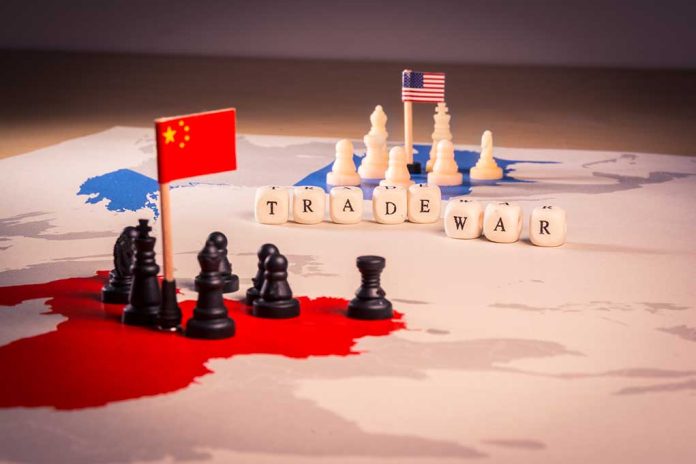
China promises swift retaliation in response to President Trump’s steep 54% tariff on imports, setting the stage for a high-stakes economic confrontation between the world’s two largest economies.
Key Takeaways
- President Trump has imposed a 54% tariff on Chinese imports, up from 20%, triggering threats of countermeasures from Beijing.
- The Chinese Commerce Ministry demanded immediate rescinding of tariffs, calling them violations of international trade rules.
- An executive order ending the “de minimis” exemption for small packages will impact companies like Shein and Temu starting May 2.
- Global markets reacted severely, with the S&P 500 experiencing its worst drop since June 2020, falling nearly 5%.
- Economists predict China’s GDP could contract by 0.5% to 1% if the tariffs remain in place.
China’s Immediate Response to Trump’s Tariff Announcement
The Chinese Commerce Ministry has issued a stern rebuke following President Trump’s announcement of a 54% tariff on all Chinese imports. In an official statement, Beijing characterized the tariffs as a “typical act of unilateral bullying” that violates international trade rules. The statement included a direct demand for the United States to immediately rescind these measures and a clear warning that China “will take resolute countermeasures to safeguard its legitimate rights and interests.” This response signals a potential revival of the trade tensions that marked Trump’s first term, with Chinese officials already beginning strategic discussions with other major economies.
Chinese Foreign Ministry spokesperson Guo Jiakun emphasized the no-win nature of the developing situation, “We have emphasized more than once that trade and tariff wars have no winners. Protectionism leads nowhere,” stated Jiakun. Despite this confrontational stance, Chinese officials indicated they would maintain communication channels with the Trump administration while simultaneously intensifying trade negotiations with the European Union, Japan, and South Korea – potentially forming a unified front against American trade policies.
China Retaliates Against Trump’s Tariffs With 34% Duties On U.S. Goodshttps://t.co/4S2Xgwkhul pic.twitter.com/VgSjmzEVZF
— Forbes (@Forbes) April 4, 2025
Market Turmoil and Economic Implications
The announcement of the tariffs triggered immediate economic turbulence, with the S&P 500 suffering its worst single-day drop since June 2020, plummeting nearly 5%. Tech stocks were particularly hard hit, with Apple experiencing a significant decline. The comprehensive nature of Trump’s tariff strategy has alarmed investors and economists alike, as it targets not only China but also applies a 10% baseline tariff to imports from 57 countries. Additional “reciprocal” tariffs are being applied to both rivals and allies, including the European Union, Japan, and India.
Economists project that if the tariffs remain in place, China’s GDP could contract by 0.5% to 1%, according to Julian Evans-Pritchard, a respected economic analyst. American consumers may also feel the pinch as tariffs are expected to increase prices for numerous goods, including produce, seafood, and staples like sugar and coffee. Despite these concerns, President Trump maintains an optimistic outlook on the economic future, stating that “The markets are going to boom. The country is going to boom.”
The De Minimis Rule Change and Its Impact
Beyond the headline tariff increases, President Trump signed an executive order eliminating the “de minimis” exemption for small packages from China and Hong Kong, effective May 2. This change will significantly impact popular e-commerce platforms like Shein and Temu, which have built business models around shipping low-cost items directly to American consumers. The exemption had previously allowed packages valued under $800 to enter the United States without duties or formal customs procedures. This move represents a targeted approach to addressing what the administration views as unfair trade advantages enjoyed by Chinese companies.
The tariffs are part of what President Trump has dubbed “Liberation Day,” framing the measures as necessary to protect American industry and address issues like the fentanyl crisis. During his 2024 campaign, Trump had considered imposing even higher tariffs of up to 60% on Chinese imports. The administration has also announced plans for additional tariffs targeting specific sectors, including semiconductors and pharmaceuticals, reflecting a comprehensive strategy to reshape the trade relationship with China and other global partners.
Sources:
Tariffs News Highlights: Tariffs Send Wall Street Tumbling to Worst Day Since Pandemic
China Vows Retaliation as Trump Unleashes ‘Bazooka’ US Tariffs
China Threatens U.S. with Retaliation If Trump Keeps Tariffs







